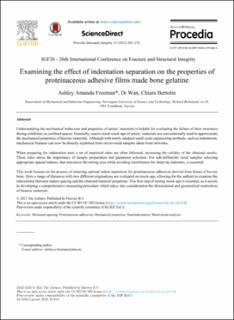| dc.contributor.author | Freeman, Ashley Amanda | |
| dc.contributor.author | Wan, Di | |
| dc.contributor.author | Bertolin, Chiara | |
| dc.date.accessioned | 2022-05-03T10:42:41Z | |
| dc.date.available | 2022-05-03T10:42:41Z | |
| dc.date.created | 2021-11-23T20:28:38Z | |
| dc.date.issued | 2021 | |
| dc.identifier.citation | Procedia Structural Integrity. 2021, 33 265-278. | en_US |
| dc.identifier.issn | 2452-3216 | |
| dc.identifier.uri | https://hdl.handle.net/11250/2993867 | |
| dc.description.abstract | Understanding the mechanical behaviour and properties of artists’ materials is helpful for evaluating the failure of their structures during exhibition in confined spaces. Generally, macro-sized mock-ups of artists’ materials are conventionally used to approximate the mechanical properties of historic materials. Although with newly adopted small-scale engineering methods, such as indentation, mechanical features can now be directly exploited from micro-sized samples taken from artworks.
When preparing for indentation tests a set of empirical rules are often followed, increasing the validity of the obtained results. These rules stress the importance of sample preparation and parameter selection. For sub-millimetre sized samples selecting appropriate spaced indents, that maximize the testing area while avoiding interference for sharp tip indenters, is essential.
This work focuses on the process of selecting optimal indent separation for proteinaceous adhesives derived from bones of bovine bone. Here a range of distances with two different originations are evaluated on mock-ups, allowing for the authors to examine the relationship between indent spacing and the obtained material properties. This first step of testing mock-ups is essential, as it assists in developing a comprehensive measuring procedure which takes into consideration the dimensional and geometrical restrictions of historic materials. | en_US |
| dc.language.iso | eng | en_US |
| dc.publisher | Elsevier | en_US |
| dc.rights | Attribution-NonCommercial-NoDerivatives 4.0 Internasjonal | * |
| dc.rights.uri | http://creativecommons.org/licenses/by-nc-nd/4.0/deed.no | * |
| dc.title | Examining the effect of indentation separation on the properties of gelatin-based films | en_US |
| dc.type | Journal article | en_US |
| dc.type | Peer reviewed | en_US |
| dc.description.version | publishedVersion | en_US |
| dc.source.pagenumber | 265-278 | en_US |
| dc.source.volume | 33 | en_US |
| dc.source.journal | Procedia Structural Integrity | en_US |
| dc.identifier.doi | 10.1016/j.prostr.2021.10.033 | |
| dc.identifier.cristin | 1958145 | |
| dc.relation.project | Norges forskningsråd: 274749 | en_US |
| cristin.ispublished | true | |
| cristin.fulltext | original | |
| cristin.qualitycode | 1 | |

